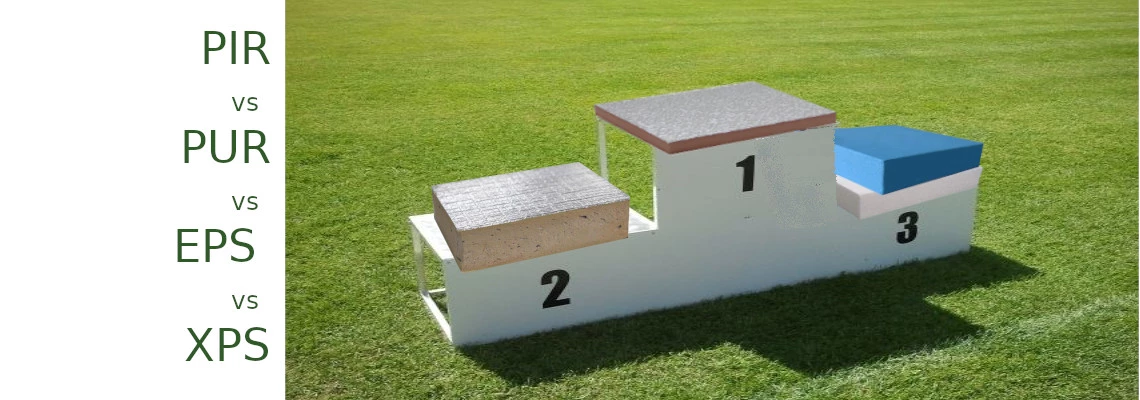
BEST TYPE OF INSULATION BOARDS| 2024 |*
Insulation boards are the best and most convenient form of insulating our home. Board doesn't come loose and never compresses after installation. Instead, it's a solid, hard foam material. Boards are simply a better solution, enabling greater savings and better thermal insulation than standard insulation roll. They come in specific dimensions, they are easy to cut and most importantly, they are very easy to carry on site.
In this article, you will learn about the pros and cons of each of them. Of course, each insulation board will include a price per m2. Below, you will also find information of the most common insulation panels, together with their applications and main points of concerns. By the end of this article you should be able to see what the best performing materials are likely to be for your application. Let’s take a closer look and discuss all types of insulation boards.
 TABLE OF CONTENTS
TABLE OF CONTENTS
- BEST TYPE OF INSULATION BOARDS
- TYPES OF INSULATION BOARDS
- PIR INSULATION BOARD (PolyIsocyanuRate)
- PHENOLIC INSULATION BOARDS
- XPS EXTRUDED INSULATION BOARDS
- EPS EXPANDED INSULATION BOARDS
TYPES OF INSULATION BOARDS
The amount of money you spend on insulation boards can vary greatly depending on the type, so it's important to know what you're getting before you buy.
When building or renovating there are 4✔ main kinds of rigid foam panels you are going to have to choose from:
- Polyisocyanurate known as Polyiso (PIR),
- Phenolic foam (PF),
- Extruded Polystyrene (XPS) - often called Styrofoam,
- Expanded Polystyrene (EPS).
Here's how they compare. The green highlights show where each insulation board type is the best. Phenolic foam is the top performer in most aspects, but it's pricey. Another good option seems to be PIR insulation board. It's not as expensive and has aluminum foil on both sides. Plus, it has one of the best balances between price and thermal conductivity.
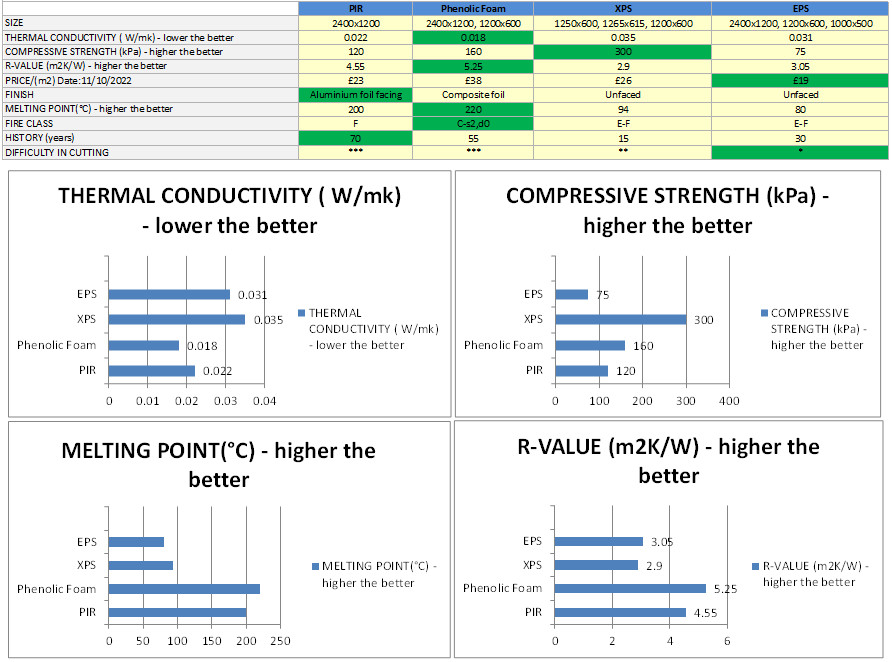
PIR vs Phenolic Board vs EPS vs XPS
INSULATION BOARDS BACKSTAGE
PIR INSULATION BOARD (PolyIsocyanuRate)
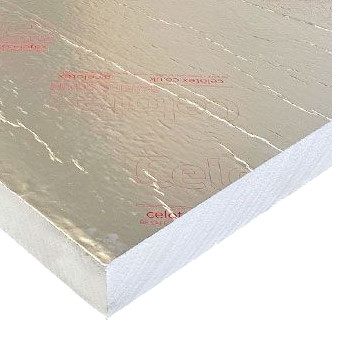 PIR insulation board, short for PolyIsocyanuRate (PIR), is one of the most capable and valuable heat resistant material used in UK constructions that can be used to insulate buildings for energy conservation. Its rigid core is usually sandwiched between two aluminium foil facings that are high performance, thus creating a tough, hard wearing yet lightweight insulation board. It is ideal for in-between and under rafters in a pitched roof or for under-slab concrete floors and also for internal stud wall applications and wall lining to existing walls, roof, wall, timber frame, loft, floor and caravan applications. The major advantage of PIR compared to other insulation materials is the insulation value. The Lambda value of PIR is situated between 0.021 to 0.032 W/mK. This means that PIR offers superior insulation with the same thickness. PIR insulation boards combine thermal efficiency with an economical price point, although the slightly better thermal performance of phenolic foam may justify the increased cost if depth in the floor construction is at a premium. PIR is used in the majority of cases as a higher thermal performance can be achieved with less material.
PIR insulation board, short for PolyIsocyanuRate (PIR), is one of the most capable and valuable heat resistant material used in UK constructions that can be used to insulate buildings for energy conservation. Its rigid core is usually sandwiched between two aluminium foil facings that are high performance, thus creating a tough, hard wearing yet lightweight insulation board. It is ideal for in-between and under rafters in a pitched roof or for under-slab concrete floors and also for internal stud wall applications and wall lining to existing walls, roof, wall, timber frame, loft, floor and caravan applications. The major advantage of PIR compared to other insulation materials is the insulation value. The Lambda value of PIR is situated between 0.021 to 0.032 W/mK. This means that PIR offers superior insulation with the same thickness. PIR insulation boards combine thermal efficiency with an economical price point, although the slightly better thermal performance of phenolic foam may justify the increased cost if depth in the floor construction is at a premium. PIR is used in the majority of cases as a higher thermal performance can be achieved with less material.
PIR insulation board is often associated with market leader Celotex company as they began producing rigid polyisocyanurate foam as first. In fact, Celotex invented the thinnest thickness of PIR insulation measuring as little as 12mm. Many PIR insulation brands, such as Celotex, Unilin, Kingspan or Recticel come with a grid marked on, which can act as a guide to help ensure the thermal insulation board is cut in a straight line.
Depending of thickness and brand, rigid insulation boards come in multiple name options, including:
- Celotex GA4000,
- Celotex TB4000,
- Celotex XR4000,
- Xtratherm Thin-R,
- Kingspan TF70,
- Kingspan TP10,
- Kingspan TW55,
- Recticel Eurothane GP,
- Quinntherm,
- EcoTherm EcoVersal,
- IKO Enertherm ALU
- Ballytherm PIR.
Thinner insulation boards, ranging from 12mm to 50mm are offered by Unilin, Celotex, IKO Enertherm, Ecotherm and Kingspan. PIR insulation boards are available in a range of thicknesses such as 12mm, 15mm, 20mm, 25mm, 30mm, 35mm, 40mm, 45mm, 50mm, 55mm, 60mm, 65mm, 70mm, 75mm, 80mm, 90mm, 100mm, 110mm, 120mm, 125mm, 130mm, 140mm, 150mm, 165mm, 180mm and 200mm.
However, the most commonly used thicknesses are 12mm, 15mm, 20mm, 25mm, 50mm and 100mm.
APPLICATION
- Cavity wall,
- Underfloor heating,
- SIP panels,
- In-between and under rafters,
- Under-slab concrete floors,
- Wall lining to existing walls,
- Roof,
- Caravan applications,
- Beam and block floors,
- Balconies and terraces,
- Timber frame wall lining,
- Timber frame walls sheathing ,
- Suspended timber floors,
- Steel stud frame walls,
- Single timber frame wall lining,
- Rain-screen cladding,
- Pitched roof sarking,
- Concrete slab floors,
- Loft and attic insulation,
- Garage conversions.
PRICE (m2): 100mm – £25
SIZE: 2400mm x 1200mm (8' x 4') (2.88m2)
THERMAL CONDUCTIVITY (λ–value): 0.022 W/mk
COMPRESSIVE STRENGTH: 120kPa
ADVANTAGES: wide applicability, provided with a vapour barrier on both sides, not corrosive to metal over time.
DISADVANTAGES: needs a nice, tight fit (for more information on how to cut PIR insulation click here).
PHENOLIC INSULATION BOARDS
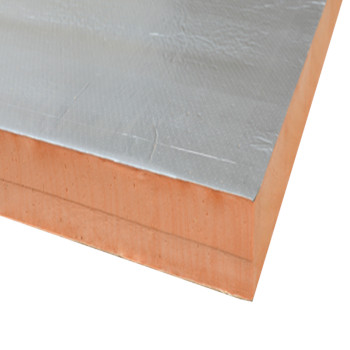 PF phenolic insulation boards (Phenolic Foam) are the most expensive but also most productive type of insulation boards. They are lightweight but strong thermosetting plastics and are considered to be one of the best rigid, closed-cell structure materials for thermal insulation at present being up to 50% more effective than other common insulation materials such as PIR. Boards are mainly intended for investors who want to achieve the standard of an energy-saving or passive house. Panels have a slightly higher R-value and a slightly thinner profile than PIR boards due to the manufacturing process. While PIR offers the lambda value of 0.022 W/mK, phenolic closed cell foam offers 0.018W/mK. In fact, that is only 10% better than PIR.
PF phenolic insulation boards (Phenolic Foam) are the most expensive but also most productive type of insulation boards. They are lightweight but strong thermosetting plastics and are considered to be one of the best rigid, closed-cell structure materials for thermal insulation at present being up to 50% more effective than other common insulation materials such as PIR. Boards are mainly intended for investors who want to achieve the standard of an energy-saving or passive house. Panels have a slightly higher R-value and a slightly thinner profile than PIR boards due to the manufacturing process. While PIR offers the lambda value of 0.022 W/mK, phenolic closed cell foam offers 0.018W/mK. In fact, that is only 10% better than PIR.
The term rigid insulation typically refers to the large pre-formed sheets of insulation which can be bought in 2400mm x 1200mm (8’ x 4’) size. The most popular thicknesses are 25mm, 50mm and 100mm. Phenolic board called Kingspan K5 brakes this magic point offering 0.28W/m²K with just 70mm board thickness. For this reason it is ideal for applications where space is at a premium. For instance, achieving a U-value of 0.28 W/m2K would require only 70mm of phenolic floor board while EPS polystyrene needs 200mm. As they’re closed cells they shouldn’t absorb moisture or water vapour, unlike partially open cell products (EPS).
High density boards have a good compressive strength and are suitable even for floors.
Boards with high density boast strong compressive strength, making them ideal for flooring. Phenolic foams, crafted with densities up to 160 kg/m³, find utility in areas with high moisture, like bathrooms and toilets. They are also effective for insulation above rafters and as thermal insulation boards placed between and beneath rafters, particularly in pitched roofs with tiles or slates.
It can be used in a variety of wall and floor applications, which makes it a great solution for a range of constructions. Used extensively in the building industry for a number of application areas including roofing (Xtratherm Safe-R SR/PR), cavity board (Xtratherm SR/CW), external wall board (Kingspan K5), plasterboard dry linings systems (Xtratherm Safe-R SR/TB or Kingspan K118) and floor insulation (Kingspan K103 or Xtratherm SR/UF Safe-R). Phenolic foam is also used in a number of highly specialised applications including fire doors, highly fire resistant panels and for insulation in surface ships, off-shore installations and submarines. It has also been used in heating, ventilating and air conditioning applications for many years.
Phenolic boards will likely be the most expensive of all the rigid foam insulation options available on the UK market, however being low thermal conductivity insulation enables high levels of thermal performance to be achieved utilising thinner sections of insulation. The exceptionally low thermal conductivity of closed cell phenolic foam boards means that appropriate insulation efficiency can be achieved with the thinnest possible material.
Depending on the design, you can choose from 2 brands. The only players on the market are - Kingspan® followed by Xtratherm®. While Kingspan offers only Kooltherm K-range, Xtratherm seems to offer a bit more. Xtratherm has products for specific projects. Depending on the application, you can choose between:
Soffit phenolic boards | Dry Lining | Cavity wall phenolic boards | Flooring Phenolic boards | Rainscreen phenolic boards | Roofing Phenolic boards | Steel and timber frame
APPLICATION:
- Dry lining,
- Cavity wall,
- Floor,
- Rainscreen insulation,
- Roofing,
- Steel and timber frame wall,
- Suspended floors,
- Ground supported floors,
- Underfloor heating systems.
PRICE (m2): 100mm - £39
SIZE: 2400mm x 1200mm (8' x 4') (2.88m2)
THERMAL CONDUCTIVITY (λ–value): 0.018 W/mk
COMPRESSIVE STRENGTH: 120kPa-160kPa
ADVANTAGES: highest fire rating among many organic insulation materials, highly resistant to water penetration, resist attack by mould and microbial growth, thinnest possible insulation board.
DISADVANTAGES: most expensive, causes pipework corrosion when it gets wet, easily crushes when walked on.
EXTRUDED INSULATION BOARDS
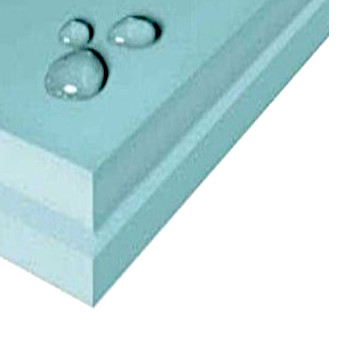 The XPS (EXtruded PolyStyrene) foam called ‘polyfoam floorboard’ or ‘styrofoam blue board’ is a fully closed cell, high density, upgrade extrusion skin panel designed especially for floor applications. Product is actually fairly inexpensive non organic styrofoam material. Chemically it’s made up of the same as EPS polystyrene but rather than being formed into droplets and then expanded, it is foamed up. Just like EPS, XPS is made of 98% air and just 2 % plastic.
The XPS (EXtruded PolyStyrene) foam called ‘polyfoam floorboard’ or ‘styrofoam blue board’ is a fully closed cell, high density, upgrade extrusion skin panel designed especially for floor applications. Product is actually fairly inexpensive non organic styrofoam material. Chemically it’s made up of the same as EPS polystyrene but rather than being formed into droplets and then expanded, it is foamed up. Just like EPS, XPS is made of 98% air and just 2 % plastic.
XPS board has no thermal drift or loss of R-Value over time. It remains waterproof over the decades. As a rule of thumb, the lower the thermal conductivity the better, because the material conducts less heat energy. For XPS polystyrene, its thermal conductivity ranges from 0.035 W/mK, which is ⅓ higher compared to phenolic insulation boards. On the other hand, as for the price, XPS is cheaper than Phenolic boards but more expensive than EPS polystyrene.
XPS polystyrene has excellent compressive strength which means it can easily cope with different flooring loads in different grades. Due to this fact, XPS is regularly used in applications where it is going to be under some strain, such as car park decks. It’s also great for use in basements or overlay roofs. XPS boards have a compressive strength of 30 tonnes per square metre, making them a lasting component for underfloor heating too. However, XPS can attract ants and termites even though it is not an organic material. XPS foam insulation is capable of withstanding over 1000 freeze/thaw cycles. Since the cells of XPS are so tightly packed, it is more moisture resistant and mildew resistant then EPS. So it is often selected in water environments.
The compressive strength of XPS is also greater than the EPS reaching 300-500 kPa. Similar to EPS there is no thermal drift or loss of R-Value over time. The thermal insulation performance of EPS and XPS in identical densities is quite close. However, EPS with the same level of density is less expensive. For more information of differences between EPS and XPS click here
Brands of XPS are generally recognizable by the colour of the insulation. XPS is typically supplied as blue, pink, green or yellow colored boards. XPS is made by Styrofoam and Dow Company, green XPS called GreenGuard is made by Kingspan and yellow XPS is made by Soprema. While they are all the same, the colour helps distinguish manufacturing companies on job sites.
APPLICATION:
- Underfloor heating,
- Garages,
- Car park,
- Commercial floor,
- Below DPC level application.
PRICE (m2): 100mm - £25
SIZE: 1250 x 600, 1265 x 615, 1200 x 600
THERMAL CONDUCTIVITY (λ–value): 035 W/mk
COMPRESSIVE STRENGTH: 300kPa
ADVANTAGES: can withstand over 1000 freeze/thaw cycles, excellent compressive strength, below DPC level application.
DISADVANTAGES: can attract ants and termites, breaks easily, fairly expensive product.
EPS POLYSTYRENE BOARDS
 If your budget is tight and you are looking for the cheapest insulation board, Expanded polystyrene called EPS is the product to go for. This budget-friendly material has a high percentage of trapped air inside which makes it an excellent premier insulator. However, unlike XPS insulation boards, EPS panels have partially closed cells which may retain water and reduce its thermal properties. It is therefore irreplaceable in applications such as External Insulation Systems (EWI) or as a fill material. Micro cellular closed cell construction provides EPS with its excellent insulating and shock absorbing characteristics.
If your budget is tight and you are looking for the cheapest insulation board, Expanded polystyrene called EPS is the product to go for. This budget-friendly material has a high percentage of trapped air inside which makes it an excellent premier insulator. However, unlike XPS insulation boards, EPS panels have partially closed cells which may retain water and reduce its thermal properties. It is therefore irreplaceable in applications such as External Insulation Systems (EWI) or as a fill material. Micro cellular closed cell construction provides EPS with its excellent insulating and shock absorbing characteristics.
In fact, EPS leads the other insulation products when it comes to R-value per £. Therefore, manufacturing costs of EPS are generally lower compared to other insulating materials like PIR or Phenolic Boards. While still offering a high thermal performance, EPS board requires slightly thicker levels to achieve the same thermal performance as PIR or Phenolic board. For example, while a project may call for 120mm of white EPS, the same thermal performance can be achieved with 70mm of PIR. On the other hand EPS polystyrene is said to be slightly easier to work with when cut. For more information on how to cut styrofoam click here.
Polystyrene board is a very practical, economic and efficient insulation product which can be applied to all areas of building construction to provide superior standards of thermal insulation.
APPLICATION:
External wall insulation,
Attic applications,
Void former,
Floor Pile collars,
Column formers,
Insulated foundation systems,
Concrete floor,
Structural insulated panels (SIPs)
PRICE (m2): 100mm - £20
SIZE: 2400 x 1200, 1000 x 500, 1200 x 600
THERMAL CONDUCTIVITY (λ–value): 0.038 W/mk
COMPRESSIVE STRENGTH: 70kPa
ADVANTAGES: 100% recyclable, cheap to buy, easy to cut.
DISADVANTAGES: can attract ants and termites, fire class-E-F.
Related articles:
Difference between EPS and XPS polystyrene boards
An exceptional performance of rigid phenolic foam
Feel the difference with XPS boards
12mm Celotex TB4012 vs 15mm Xtratherm Thin-r
*All the information provided in the content published on Insulationgo blog is for informational and educational purposes only. Insulationgo LTD makes every effort to ensure the accuracy and timeliness of the content, but we do not assume any responsibility for any errors or omissions.
The information presented on this blog should not be considered as professional advice or a substitute for consulting relevant experts. Before making any purchase decisions or taking action based on the information presented here, it is strongly recommended to contact the product manufacturer directly to verify the details and ensure its suitability for your specific needs.
By using this blog, you acknowledge and agree that Insulationgo LTD shall not be held liable for any damages, losses, or inconveniences arising from the use or reliance on the information provided herein. This limitation of liability applies to all users of the blog, including but not limited to visitors, readers, and subscribers.










































































































